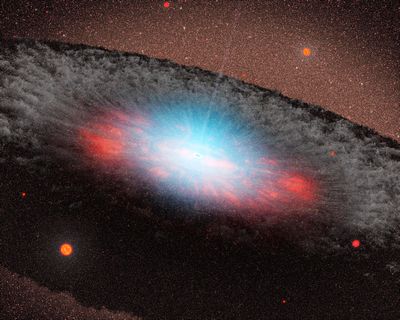
An international team led by astronomer Paul van der Werf (Leiden University, The Netherlands) has discovered that a black hole in the young universe is surrounded by a large disk of gas and dust, where stars form rapidly and which is so dense that light can barely escape from it. The team made this unexpected discovery during a successful search for water vapour in a galaxy in the early universe, located at a distance of 12 billion light-years. The discovery was made using the sensitive radio telescopes of IRAM (Institut de Radioastronomie Millimétrique) at the Plateau de Bure in the French Alps. These telescopes were used to search for water vapour in a quasar, a galaxy in the early universe that derives its luminosity from the growth of a black hole hundreds of millions of times more massive than our sun. Team leader Paul van der Werf says: "Water in cosmic clouds is normally frozen to ice, but the ice can be evaporated by the strong radiation of the quasar or of young stars. Therefore we decided to search for water vapour in this object. It is located so far away that we are looking back in time, to an era where the universe was only 10% of its present age. This is one of the first searches ever conducted to find water in the early universe." The big surprise was however not the amount of water vapour found (1000 trillion times the amount of water on Earth) but the discovery of an opaque disk in which the water vapour is located and which rapidly forms young stars. The density of the disk is so high that light barely escapes. Team member Marco Spaans (University of Groningen, The Netherlands) explains: "Water molecules are sensitive to infrared radiation, so we could use the water vapour detected as a cosmic infrared light meter. With this method we found that essentially all radiation is locked up in the gas disk surrounding the black hole. This trapped radiation is so intense that it will build up enormous pressure and eventually blow away the gas and dust clouds surrounding the black hole." See the webside for more details: http://www.astron.nl/about-astron/press-public/news/water-vapour-reveals-how-stars-form-around-black-hole/water-vapour (SY) |




